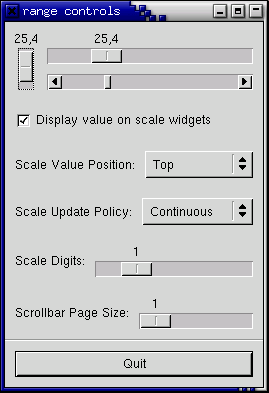This example is a somewhat modified version of the "range controls" test from testgtk.c. It basically puts up a window with three range widgets all connected to the same adjustment, and a couple of controls for adjusting some of the parameters mentioned above and in the section on adjustments, so you can see how they affect the way these widgets work for the user.

use Glib qw/TRUE FALSE/;
use Gtk2 '-init';
my ($hscale, $vscale);
sub cb_pos_menu_select
{
my ($widget, $pos) = @_;
$hscale->set_value_pos($pos);
$vscale->set_value_pos($pos);
}
sub cb_update_menu_select
{
my ($widget, $policy) = @_;
$hscale->set_update_policy($policy);
$vscale->set_update_policy($policy);
}
sub cb_digits_scale
{
my ($adjustment) = @_;
# Set the number of decimal places to which adj->value is rounded
$hscale->set_digits($adjustment->value);
$vscale->set_digits($adjustment->value);
}
# We do not have a Glib::CLAMP function, so we provide it here.
sub clamp ($val, $low, $high)
{
return (($val > $high) ? $high : (($val < $low) ? $low : $val));
}
sub cb_page_size
{
my ($get, $set) = @_;
# Set the page size and page increment size of the sample
# adjustment to the value specified by the "Page Size" scale
$set->page_size($get->value);
$set->page_increment($get->value);
# This sets the adjustment and make it emit the "changed" signal to
# reconfigure all the widgets that are attached to this signal.
$set->set_value(clamp ($set->value,
$set->upper - $set->page_size,
$set->lower));
$set->signal_emit("changed");
}
sub cb_draw_value
{
my $button = shift;
$hscale->set_draw_value($button->get_active());
$vscale->set_draw_value($button->get_active());
}
# Convenience functions
sub make_menu_item
{
my ($name, $func, $data) = @_;
$item = Gtk2::MenuItem->new_with_label($name);
$item->signal_connect(activate => $func, $data);
$item->show;
return $item;
}
sub scale_set_default_values
{
my $scale = shift;
$scale->set_update_policy('continuous');
$scale->set_digits(1);
$scale->set_value_pos('top');
$scale->set_draw_value(TRUE);
}
# makes the sample window
sub create_range_controls
{
# Standard window-creating stuff
$window = Gtk2::Window->new('toplevel');
$window->signal_connect(destroy => sub { Gtk2->main_quit; });
$window->set_title("range controls");
$box1 = Gtk2::VBox->new(FALSE, 0);
$window->add($box1);
$box1->show;
$box2 = Gtk2::HBox->new(FALSE, 10);
$box2->set_border_width(10);
$box1->pack_start($box2, TRUE, TRUE, 0);
$box2->show;
# value, lower, upper, step_increment, page_increment, page_size
# Note that the page_size value only makes a difference for
# scrollbar widgets, and the highest value you'll get is actually
# (upper - page_size).
$adj1 = Gtk2::Adjustment->new(0.0, 0.0, 101.0, 0.1, 1.0, 1.0);
$vscale = Gtk2::VScale->new($adj1);
scale_set_default_values($vscale);
$box2->pack_start($vscale, TRUE, TRUE, 0);
$vscale->show;
$box3 = Gtk2::VBox->new(FALSE, 10);
$box2->pack_start($box3, TRUE, TRUE, 0);
$box3->show;
# Reuse the same adjustment
$hscale = Gtk2::HScale->new($adj1);
$hscale->set_size_request(200, -1);
scale_set_default_values($hscale);
$box3->pack_start($hscale, TRUE, TRUE, 0);
$hscale->show;
# Reuse the same adjustment again
$scrollbar = Gtk2::HScrollBar->new($adj1);
# Notice how this causes the scales to always be updated
# continuously when the scrollbar is moved
$scrollbar->set_update_policy('continuous');
$box3->pack_start($scrollbar, TRUE, TRUE, 0);
$scrollbar->show;
$box2 = Gtk2::HBox->new(FALSE, 10);
$box2->set_border_width(10);
$box1->pack_start($box2, TRUE, TRUE, 0);
$box2->show;
# A checkbutton to control whether the value is displayed or not
$button = Gtk2::CheckButton->new("Display value on scale widgets");
$button->set_active(TRUE);
$button->signal_connect(toggled => \&cb_draw_value);
$box2->pack_start($button, TRUE, TRUE, 0);
$button->show;
$box2 = Gtk2::HBox->new(FALSE, 10);
$box2->set_border_width(10);
# An option menu to change the position of the value
$label = Gtk2::Label->new("Scale Value Position:");
$box2->pack_start($label, FALSE, FALSE, 0);
$label->show;
$opt = Gtk2::OptionMenu->new;
$menu = Gtk2::Menu->new;
$item = make_menu_item("Top", \&cb_pos_menu_select, 'top');
$menu->append($item);
$item = make_menu_item("Bottom", \&cb_pos_menu_select, 'bottom');
$menu->append($item);
$item = make_menu_item("Left", \&cb_pos_menu_select, 'left');
$menu->append($item);
$item = make_menu_item("Right", \&cb_pos_menu_select, 'right');
$menu->append($item);
$opt->set_menu($menu);
$box2->pack_start($opt, TRUE, TRUE, 0);
$opt->show;
$box1->pack_start($box2, TRUE, TRUE, 0);
$box2->show;
$box2 = Gtk2::HBox->new(FALSE, 10);
$box2->set_border_width(10);
# Yet another option menu, this time for the update policy of the
# scale widgets
$label = Gtk2::Label->new("Scale Update Policy:");
$box2->pack_start($label, FALSE, FALSE, 0);
$label->show;
$opt = Gtk2::OptionMenu->new;
$menu = Gtk2::Menu->new;
$item = make_menu_item("Continuous", \&cb_update_menu_select, 'continuous');
$menu->append($item);
$item = make_menu_item("Discontinuous", \&cb_update_menu_select, 'discontinuous');
$menu->append($item);
$item = make_menu_item("Delayed", \&cb_update_menu_select, 'delayed');
$menu->append($item);
$opt->set_menu($menu);
$box2->pack_start($opt, TRUE, TRUE, 0);
$opt->show;
$box1->pack_start($box2, TRUE, TRUE, 0);
$box2->show;
$box2 = Gtk2::HBox->new(FALSE, 10);
$box2->set_border_width(10);
# An HScale widget for adjusting the number of digits on the
# sample scales.
$label = Gtk2::Label->new("Scale Digits:");
$box2->pack_start($label, FALSE, FALSE, 0);
$label->show;
$adj2 = Gtk2::Adjustment->new(1.0, 0.0, 5.0, 1.0, 1.0, 0.0);
$adj2->signal_connect(value_changed => \&cb_digits_scale);
$scale = Gtk2::HScale->new($adj2);
$scale->set_digits(0);
$box2->pack_start($scale, TRUE, TRUE, 0);
$scale->show;
$box1->pack_start($box2, TRUE, TRUE, 0);
$box2->show;
$box2 = Gtk2::HBox->new(FALSE, 10);
$box2->set_border_width(10);
# And, one last HScale widget for adjusting the page size of the
# scrollbar.
$label = Gtk2::Label->new("Scrollbar Page Size:");
$box2->pack_start($label, FALSE, FALSE, 0);
$label->show;
$adj2 = Gtk2::Adjustment->new(1.0, 1.0, 101.0, 1.0, 1.0, 0.0);
$adj2->signal_connect(value_changed => \&cb_page_size, $adj1);
$scale = Gtk2::HScale->new($adj2);
$scale->set_digits(0);
$box2->pack_start($scale, TRUE, TRUE, 0);
$scale->show;
$box1->pack_start($box2, TRUE, TRUE, 0);
$box2->show;
$separator = Gtk2::HSeparator->new;
$box1->pack_start($separator, FALSE, TRUE, 0);
$separator->show;
$box2 = Gtk2::VBox->new(FALSE, 10);
$box2->set_border_width(10);
$box1->pack_start($box2, FALSE, TRUE, 0);
$box2->show;
$button = Gtk2::Button->new("Quit");
$button->signal_connect(clicked => sub { Gtk2->main_quit; });
$box2->pack_start($button, TRUE, TRUE, 0);
$button->can_default(TRUE);
$button->grab_default;
$button->show;
$window->show;
}
create_range_controls();
Gtk2->main;
0;
|
You will notice that the program does not call Glib::Object::signal_connect() for the "delete_event", but only for the "destroy" signal. This will still perform the desired function, because an unhandled "delete_event" will result in a "destroy" signal being given to the window.